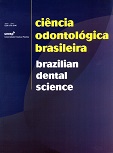Prevalência de microrganismos periodontais intra e extra sulcular em crianças, adolescentes e adultos jovens
DOI:
https://doi.org/10.14295/bds.2007.v10i3.297Abstract
A instalação e progressão da doença periodontal estão associadas à presença de fatores de risco destacando-se entre eles determinadas espécies bacterianas. A proposta do presente estudo, do tipo transversal, foi avaliar por reação em cadeia da polimerase a prevalência de A. actinomycetemcomitans, P. gingivalis, P. intermedia, T. forsythensis e C. rectus no sulco gengival, na mucosa do dorso da língua e da bochecha em crianças, adolescentes e adultos jovens entre 2 ½ até 18 anos de idade. Foram realizadas associações dos periodontopatógenos com idade, sexo e condição periodontal. A condição periodontal foi estabelecida pelos índices de placa (IP), gengival (IG), profundidade de sondagem e nível de inserção clínica. Para análise dos dados foram utilizados os testes Qui-Quadrado e Exato de Fischer para a distribuição das variáveis qualitativas, t-Student para a variável IP; Mann-Whitney para a variável IG. Os resultados mostraram que as bactérias de maior e menor prevalência foram respectivamente C. rectus (94%) e P. gingivalis (2%), sendo esta última somente encontrada em sulco gengival de adolescentes e adultos jovens. A faixa etária de menor idade apresentou as mais baixas prevalências bacterianas. O sexo não interferiu na prevalência microbiana da população estudada. Observou-se uma pior condição clínica quando parâmetros periodontais estiveram associados a T. forsythensis e P. intermedia. Assim, concluímos que C. rectus foi a bactéria mais prevalente sendo o sítio intra-sulcular o mais favorável para a colonização bacteriana e, a pior condição clínica periodontal associou-se a T. forsythensis e P. intermedia.
Downloads
Downloads
Published
How to Cite
Issue
Section
License
Brazilian Dental Science uses the Creative Commons (CC-BY 4.0) license, thus preserving the integrity of articles in an open access environment. The journal allows the author to retain publishing rights without restrictions.
=================




























